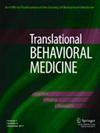A dynamic, multilevel process evaluation of a produce prescription program at a federally qualified health center: 2017–2021 description, implementation, and infrastructure
IF 3.6
3区 医学
Q1 PUBLIC, ENVIRONMENTAL & OCCUPATIONAL HEALTH
引用次数: 0
Abstract
The “Food as Medicine” (FAM) movement encourages public health and medical professionals to recognize the importance of dietary patterns and food access. The purpose of this work was to describe patient and physician engagement with a produce prescription (PRx) program to improve access to fresh vegetables in a healthcare setting. A Federally Qualified Health Center, regenerative farm, and academic institution partnered for the PRx program (2017–21). During harvest seasons, patients redeemed “prescriptions” for initial and “refill” produce boxes. Baseline food insecurity surveys were embedded in electronic medical records. Refill surveys assessed satisfaction and confidence. Electronic surveys to prescribing physicians assessed program knowledge, expectations, and motivations. Across 8 biannual harvests generating 9986 produce boxes, 8046 patients received prescriptions, 6227 redeemed prescriptions for ≥1 box, and 720 redeemed for ≥2 boxes. Seasonally, initial redemption rates ranged from 64.5% to 82.7%; refill rates ranged from 6.8% to 16.7%. Among participants, 70.8% sometimes/often worried food would run out and 66.7% sometimes/often ran out of food. Among those with refills, there was high satisfaction with food quality (95.8%) and variety (97.2%), and 94.2% were confident preparing meals from produce. Among physicians (n = 22), 100% self-reported adequate knowledge about PRx for patient recommendations, and 100% believed PRx had benefit for patients. Chronic conditions (77%), low socioeconomic status (64%), and food insecurity (59%) were common motivating factors for prescriptions. We demonstrated the feasibility of implementing a cross-sector, seasonal PRx program within a multisite healthcare system. More research is needed to refine implementation toward greater patient refill rates.对联邦合格保健中心农产品处方计划的动态、多层次过程评估:2017-2021 年说明、实施和基础设施
食物即药物"(FAM)运动鼓励公共卫生和医疗专业人员认识到饮食模式和食物获取的重要性。这项工作的目的是描述病人和医生参与农产品处方(PRx)计划的情况,以改善在医疗机构中获取新鲜蔬菜的机会。联邦合格卫生中心、再生农场和学术机构合作开展了 PRx 计划(2017-21 年)。在收获季节,患者用 "处方 "兑换首盒和 "续盒 "农产品。基线食物不安全调查被嵌入电子病历中。续订调查评估满意度和信心。对开具处方的医生进行的电子调查评估了计划的知识、期望和动机。8 次一年两次的收获共产生了 9986 个农产品盒,其中 8046 名患者获得了处方,6227 名患者兑换了≥1 盒的处方,720 名患者兑换了≥2 盒的处方。从季节上看,首次换药率从 64.5% 到 82.7% 不等;再次换药率从 6.8% 到 16.7% 不等。在参与者中,70.8%的人有时/经常担心食物会吃完,66.7%的人有时/经常吃不完食物。在补充过食物的参与者中,对食物质量(95.8%)和种类(97.2%)的满意度很高,94.2%的人有信心用农产品做饭。在医生(22 人)中,100% 的人自称对 PRx 有足够的了解,可以向病人推荐,100% 的人认为 PRx 对病人有益。慢性疾病(77%)、社会经济地位低下(64%)和食品不安全(59%)是处方的常见诱因。我们证明了在多地点医疗保健系统中实施跨部门、季节性 PRx 计划的可行性。我们还需要开展更多的研究来完善该计划的实施,以提高患者的续订率。
本文章由计算机程序翻译,如有差异,请以英文原文为准。
求助全文
约1分钟内获得全文
求助全文
来源期刊

Translational Behavioral Medicine
PUBLIC, ENVIRONMENTAL & OCCUPATIONAL HEALTH -
CiteScore
6.80
自引率
0.00%
发文量
87
期刊介绍:
Translational Behavioral Medicine publishes content that engages, informs, and catalyzes dialogue about behavioral medicine among the research, practice, and policy communities. TBM began receiving an Impact Factor in 2015 and currently holds an Impact Factor of 2.989.
TBM is one of two journals published by the Society of Behavioral Medicine. The Society of Behavioral Medicine is a multidisciplinary organization of clinicians, educators, and scientists dedicated to promoting the study of the interactions of behavior with biology and the environment, and then applying that knowledge to improve the health and well-being of individuals, families, communities, and populations.
 求助内容:
求助内容: 应助结果提醒方式:
应助结果提醒方式:


